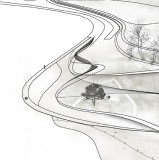Design Studio Required Elective at semester(s) 6, 8, ECTS: 12
Generic Competences: Ability to search for, process and analyse information from a variety of sources using the necessary technologies, Ability to make reasoned decisions, Ability to work in a team, Ability to work in an interdisciplinary environment, Capacity to generate new ideas (creativity), Commitment to conservation of the environment.
The studio focuses on the ‘landform building’ genealogy, the interdisciplinarymode of operation between landscape and architecture that has generated a multitude of ‘green roofs, artificial mountains and geological forms; buildings you walk on or over; networks of ramps and warped surfaces; buildings that carve into the ground or landscapes lifted high into the air’ (Allen & McQuade, 2011) sustaining at the same time an outlook towards a bio-digital research agenda.
Comprehension, Application, Analysis, Synthesis
A relational research agenda is developed during the design process. Specifically students may explore:
-Form generation potential of single surfaces in relation to the creation of artificial ground.
-Emergent morphogenetic phenomena in relation to spatial allocation.
-Activities of a ‘modern’ recreation program in relation to appropriations of the urban landscape.
-State of the art material systems in relation to local resources.
The design objectives of the studio are both extensive (concerning the analysis and programming of large scale surfaces and the organization of flows) and intensive (small scale objects that facilitate a certain activity system). The area of study is the coastal stretch between the estuaries of river Nestos and the peninsula of Keramoti. Students select the locations for intervention according to their scenario.The field trip to the location is instrumental to design development both to confront design presuppositions in the real setting situation and to interact with local authorities.
Students are evaluated on the basis of an introductory exercise (25%) and the Design Assignment (75%).The introductory exercise is research based and contributes to a collective repository of strategies and tools. The design assignment deliverable is a full presentation set of drawings (definitive design level).
Allen, S. and McQuade, M. eds. 2011. Landform Building: Architecture’s new terrain. Baden and Princeton: Lars Muller Publishers and Princeton University School of Architecture
Cruz, M. 2013. The Inhabitable Flesh of Architecture. Ashgate
Vyzoviti, S. 2014. "Spontaneous Landforming" in Zavraka, D. ed. Urban Blur. CNND Publications
Weinstock, M. 2010. The Architecture of Emergence: The evolution of form in nature and civilization. Wiley & Sons.
land-form building, hybrid ecologies, bio-digital
http://hybridecologies.tumblr.com/



